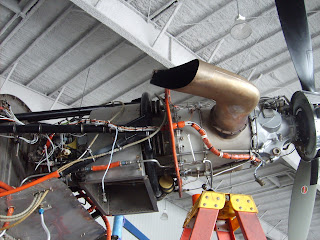Rapid Response to MFI
Recently, myself and two others from MMS took the two engines we worked on and their propellers back down to Missionary Flights International in Fort Pierce, Florida to reinstall them on the Cessna 310.
 |
| Cessna 310 with left engine installed and DC-3 in background. |
 |
| Close up of left engine. |
 |
| Changing fuel nozzles on a PT-6. |
 |
| PT-6 turboprop. |
I asked one of the mechanics that has been with MFI for a few decades about the old engines versus the PT-6. He said that when they did their cost analysis, they found that flying with the PT-6 actually saved them about $2,000.00 a flight! That's big news when you have around three scheduled flights a week.
In addition to working on a DC-3, I got to do two other new things as well. I was asked if I wanted to go on one of the scheduled flights to Haiti and of course said yes. What this meant was I would need to pass my flight attendant test. So I was to go to a new country for me and join the ranks of flight attendants all in the same day.
Now, after you get back up off the floor and stop laughing enough to read on, I am happy to assure you that my uniform did not include a skirt or one of those poofy scarf things that you wear around your neck, just to be clear.
We took off from Ft. Pierce, FL with about half a plane of cargo and the other half full of a short term mission team and flew to Exuma, Bahamas for fuel. Here we had to get off the plane and wait inside the "terminal" while the fueling was accomplished. After a little while, the captain of the flight came and announced that the customs personnel had gone on strike and talks were going on to get us back on the plane and on our way. I don't know what happened to change their minds, but we got the green light to reboard shortly after that.
 |
| Parked for fuel at Cap Haitien, Haiti. |
 |
| Pignon, Haiti |
 |
| Bring on the passengers! |
After we unloaded and the customs officer did his inspections and paperwork, we loaded up some people that were coming back to the states and the customs officer and headed back to Cap-Haitien to get fuel. After dropping off the officer and fueling, we headed home. Almost four hours later we landed back at Ft. Pierce and unloaded all of the people and their bags, went through customs to get back stateside then put the plane to bed for the night.
It was great to see how another mission works and actually get to go to the field as well. Thanks for all your prayers and support as we prepare for worldwide mission service!
In His love, Ben

Comments
Post a Comment